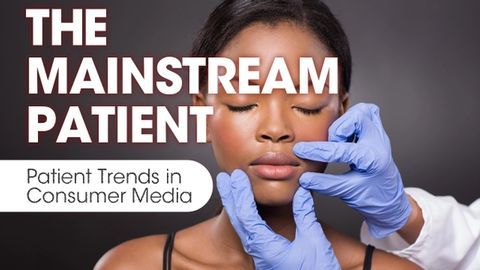- Case-Based Roundtable
- General Dermatology
- Eczema
- Chronic Hand Eczema
- Alopecia
- Aesthetics
- Vitiligo
- COVID-19
- Actinic Keratosis
- Precision Medicine and Biologics
- Rare Disease
- Wound Care
- Rosacea
- Psoriasis
- Psoriatic Arthritis
- Atopic Dermatitis
- Melasma
- NP and PA
- Skin Cancer
- Hidradenitis Suppurativa
- Drug Watch
- Pigmentary Disorders
- Acne
- Pediatric Dermatology
- Practice Management
- Prurigo Nodularis
- Buy-and-Bill
Article
The Mainstream Patient: April 10
Author(s):
This week's edition of the Mainstream Patient features stories about filler fatigue in 2023, the difference between RF microneedling and traditional microneedling, IPL hair removal devices, and more.
New this week: Allure takes a closer look at consumers ditching facial filler in 2023 and Elle explores how the latest beauty trends aren't focusing on absolutely flawless skin. NewBeauty asks dermatologists to explain RF microneedling and InStyle reveals Amazon's secret spring beauty sale. Women's Health talks to dermatologists about broken capillaries and Self looks at the pros and cons of IPL hair removal devices according to dermatologists.
In 2023, Will Everyone Abandon Their Facial Filler?
"There's an affliction plaguing the aesthetics world: 'filler fatigue,' a uniquely 21st-century condition that results from overindulging in hyaluronic acid fillers — in your lips, cheeks, nasolabial folds, or anywhere else on your face. And while the term aptly captures the weariness of our modern obsession with ever-plumper features, it actually started floating around dermatology circles years ago as a synonym for the overfilled face — shorthand for its uncanny puffiness. In 2023, 'filler fatigue' has entered the lexicon of the average aesthetics patient — and cultural observer."
Redefining Nice Skin
"Nice skin has always meant one thing—perfection. And that’s also meant a never-ending number of ways to chase it. While some have genetics to thank (can we call that nepo skin?), others have sought out filters, lasers, and skin care routines requiring their own spreadsheets. In our quest for 'nice skin,' we’ve indulged in some not-nice skin behaviors— picking at our blemishes; overusing burning facial toners and damaging our skin barrier; and fiercely judging our skin for not always being flawless."
What’s the Difference Between RF Microneedling and Traditional Microneedling?
"Prospect, KY dermatologist Tami Buss Cassis, MD, says, 'The easiest way to explain microneedling is that ‘micro’-size needles create tiny holes, or wounds, in the top layers of the skin, which then promotes wound healing and stimulates the production of collagen and elastin fibers. As the skin heals, fine lines, pore size, and overall texture improve to rejuvenate the appearance of the skin. The treatment is also used to smooth a variety of scars, including those from acne and stretch marks."
Everything You Need To Know About Broken Capillaries (And How to Treat Them)
"Taking a magnifying mirror to the face is never a fully positive experience—especially when you sit under the fluorescent bathroom lights in hopes of a satisfying extraction, and instead come across clusters of tiny red veins dotting your cheeks or nose. These unnerving little splotches, also known as broken capillaries, are common. And, luckily, they're treatable. We spoke to top dermatologists to get the 4-1-1 on what causes broken capillaries, how to treat them, and how to prevent them in the first place."
What’s Up With IPL Hair Removal Devices?
"IPL, or intense pulsed light, is a broad wavelength of light. That means an IPL device releases multiple types of light—red, yellow, green, and infrared—that together can target different elements of the skin, including melanin (the pigment that gives skin and hair a particular color) and hemoglobin (a protein in blood cells that can contribute to skin redness—or lack thereof). Because of that, IPL can have an effect on blood vessels, dark spots, and hair follicles. 'IPL hair removal works by targeting the pigment in the hair follicle, heating it, and ultimately destroying the follicle, Aanand Geria, MD, a board-certified dermatologist based in Verona, New Jersey, tells SELF."
Amazon’s Secret Spring Beauty Sale Is Overflowing With Viral Deals, Starting at Just $5
"While new year's resolutions have come and gone, spring is the real season to refresh your life. Whether you’re redecorating your space or purging your wardrobe, spring cleaning can look different for everyone. Personally, I plan to give my beauty cabinet a major makeover by swapping out the products that no longer serve me (and are likely expired) for budget-friendly, customer-loved picks. To no surprise, Amazon is the first place I’m turning to."



